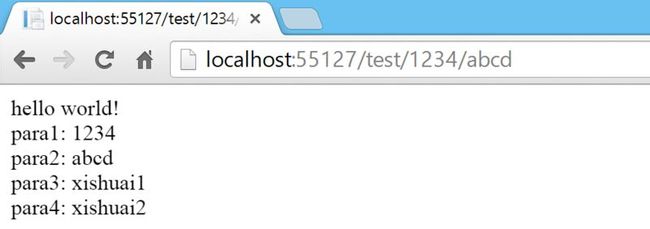WebForm MapPageRoute 路由配置
WebForm MapPageRoute 路由配置
MapPageRoute 应该是 ASP.NET 4.0 中的东西,但现在我是第一次使用它,使用场景是:MVC 混合使用 WebForm,然后对 WebForm 进行路由配置,当然也可以使用 ISAPI_Rewrite 3,不同的是要在 IIS 中配置,相对而言,MapPageRoute 在程序中进行配置更加灵活方便,下面是关于 MapPageRoute 的简单整理。
1. 最简单:
public class MvcApplication : System.Web.HttpApplication { protected void Application_Start() { RouteTable.Routes.MapPageRoute("WebFormRoute", "test", "~/WebForm1.aspx"); } } public partial class WebForm1 : System.Web.UI.Page { protected void Page_Load(object sender, EventArgs e) { Response.Write("hello world!"); } }效果:
2. 带参数:
public class MvcApplication : System.Web.HttpApplication { protected void Application_Start() { RouteTable.Routes.MapPageRoute("WebFormRoute", "test/{para}", "~/WebForm1.aspx"); } } public partial class WebForm1 : System.Web.UI.Page { protected void Page_Load(object sender, EventArgs e) { Response.Write("hello world! <br />"); Response.Write("para: " + Page.RouteData.Values["para"]); } }效果:
注意:
当我们使用参数映射的时候,在获取参数值使用的是 Page.RouteData.Values,而不是 Request.QueryString,有一种情况是,如果你的 Url 映射还是 WebForm1.aspx 文件名的形式,只不过这个文件地址发生了变化,这时候你就不需要在 MapPageRoute 中进行参数配置了,只需要进行 Url 和 WebForm 文件地址配置,那这样配置,使用 Request.QueryString 可以获取到参数值吗?我试过是可以的,没有了参数映射配置,也就不需要 Page.RouteData.Values 进行获取参数值了,一种偷巧行为。
3. 带多个参数:
public class MvcApplication : System.Web.HttpApplication { protected void Application_Start() { RouteTable.Routes.MapPageRoute("WebFormRoute", "test/{para1}/{para2}", "~/WebForm1.aspx"); } } public partial class WebForm1 : System.Web.UI.Page { protected void Page_Load(object sender, EventArgs e) { Response.Write("hello world! <br />"); Response.Write("para1: " + Page.RouteData.Values["para1"]+ "<br />"); Response.Write("para2: " + Page.RouteData.Values["para2"]+ "<br />"); } }效果:
注意:
多个参数的映射还有一种写法是:test/{para1}&{para2},但我试过这种写法会报错,而在 Scott Guthrie 的一篇博文中评论回复,这种方式是可以的,如下:
4. 非正规参数:
public class MvcApplication : System.Web.HttpApplication { protected void Application_Start() { RouteTable.Routes.MapPageRoute("WebFormRoute", "test/{para1}/{para2}.html", "~/WebForm1.aspx"); } } public partial class WebForm1 : System.Web.UI.Page { protected void Page_Load(object sender, EventArgs e) { Response.Write("hello world! <br />"); Response.Write("para1: " + Page.RouteData.Values["para1"]+ "<br />"); Response.Write("para2: " + Page.RouteData.Values["para2"]+ "<br />"); } }效果:
注意:
<system.webServer> <modules runAllManagedModulesForAllRequests="true" /> </system.webServer>在 MapPageRoute Url 映射的时候,使用的后缀是 .html,需要在 web.config 添加上面配置,如果使用的是 .aspx,则不需要,runAllManagedModulesForAllRequests 在之前的博文中有说过,就不重复了。
4. MapPageRoute 方法参数:
//参数 public Route MapPageRoute( string routeName,//路由的名称。 string routeUrl,//路由的 URL 模式。 string physicalFile,//路由的物理 URL。 bool checkPhysicalUrlAccess,//一个值,该值指示 ASP.NET 是否应验证用户是否有权访问物理 URL(始终会检查路由 URL)。 RouteValueDictionary defaults,//路由参数的默认值。 RouteValueDictionary constraints,//一些约束,URL 请求必须满足这些约束才能作为此路由处理。 RouteValueDictionary dataTokens//与路由关联的值,但这些值不用于确定路由是否匹配 URL 模式。 ) public class MvcApplication : System.Web.HttpApplication { protected void Application_Start() { RouteTable.Routes.MapPageRoute("WebFormRoute", "test/{para1}/{para2}/{*queryvalues}", "~/WebForm1.aspx", false, null, new RouteValueDictionary { { "para1", "^[0-9]*$" }, { "para2", "^[A-Za-z]+$" } }, new RouteValueDictionary { { "para3", "xishuai1" }, { "para4", "xishuai2" } }); } } public partial class WebForm1 : System.Web.UI.Page { protected void Page_Load(object sender, EventArgs e) { Response.Write("hello world! <br />"); Response.Write("para1: " + Page.RouteData.Values["para1"]+ "<br />"); Response.Write("para2: " + Page.RouteData.Values["para2"]+ "<br />"); Response.Write("para3: " + Page.RouteData.DataTokens["para3"] + "<br />"); Response.Write("para4: " + Page.RouteData.DataTokens["para4"]+ "<br />"); } }效果:
参考资料:





